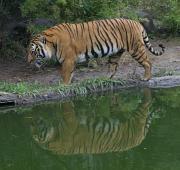 The Indochinese tiger (also known as the Corbett's tiger) is a subspecies of tiger, found throughout south-east Asia. The Indochinese tiger is now an endangered species and actually thought to be extinct in the Chinese wild today.
The Indochinese tiger (also known as the Corbett's tiger) is a subspecies of tiger, found throughout south-east Asia. The Indochinese tiger is now an endangered species and actually thought to be extinct in the Chinese wild today. The Indochinese tiger is found throughout Cambodia, Laos, Thailand, Burma and Vietnam, although the Indochinese tiger's range is much smaller now than it once was and no Indochinese tigers have been seen in the wild in China since 2007.
The Indochinese tiger is found throughout Cambodia, Laos, Thailand, Burma and Vietnam, although the Indochinese tiger's range is much smaller now than it once was and no Indochinese tigers have been seen in the wild in China since 2007.


The Indochinese tiger is a dominant and carnivorous predator, hunting it's prey by stalking it until the Indochinese tiger has the opportunity to catch it off guard. Indochinese tigers primarily hunt larger mammals including deer, wild boar, cattle and goats.
Due to the size and power of the Indochinese tiger, it has no natural predators in its native environment. Humans that hunt the Indochinese tiger and habitat loss are the only threats to the Indochinese tiger.
After a gestation period of 3 to 4 months, the female Indochinese tiger gives birth to up to 5 cubs. Newborn Indochinese tiger cubs weigh about 1 kg (2 lb) and are blind and helpless. The mother feeds them milk for about 2 months and then the Indochinese tiger cubs are introduced to meat. Indochinese tiger cubs depend on their mother for the first 18 months and then they start hunting on their own.
Today, due to habitat loss caused by deforestation, and hunting by human poachers, the Indochinese tiger is considered to be an endangered species. Modern estimates suggest that the current wild Indochinese tiger population is between 1,200 and 1,800 individuals.

